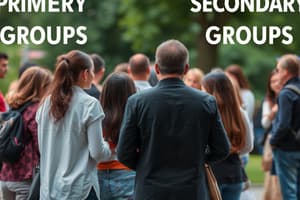Podcast
Questions and Answers
Which of the following is NOT a characteristic of a group?
Which of the following is NOT a characteristic of a group?
- Individuals share the same physical space.
- Individuals interact with each other.
- Individuals consider themselves as belonging together.
- Individuals share the same characteristics. (correct)
Which of the following is NOT considered a primary group?
Which of the following is NOT considered a primary group?
- Close-knit neighborhood group.
- Work colleagues. (correct)
- Childhood friends.
- Family.
What is the main difference between primary groups and secondary groups?
What is the main difference between primary groups and secondary groups?
- Primary groups are based on personal relationships, while secondary groups are based on shared interests or goals. (correct)
- Primary groups are smaller, while secondary groups are larger.
- Primary groups are more important than secondary groups.
- Primary groups are more stable than secondary groups.
Secondary groups can never break down into primary groups.
Secondary groups can never break down into primary groups.
What are reference groups, and how do they influence individuals?
What are reference groups, and how do they influence individuals?
What concept describes the process of social organizations becoming increasingly characterized by efficiency, predictability, calculability, and control?
What concept describes the process of social organizations becoming increasingly characterized by efficiency, predictability, calculability, and control?
What is the main argument of George Ritzer's theory of McDonaldization?
What is the main argument of George Ritzer's theory of McDonaldization?
Which of the following is NOT a characteristic of a bureaucracy, according to Max Weber?
Which of the following is NOT a characteristic of a bureaucracy, according to Max Weber?
Flashcards
Aggregate
Aggregate
Individuals who share the same physical space but do not interact or consider themselves belonging together.
Category
Category
Individuals who share a common characteristic but do not interact with each other.
Group
Group
Individuals who interact with each other and consider themselves belonging together.
Primary Groups
Primary Groups
Signup and view all the flashcards
Secondary Groups
Secondary Groups
Signup and view all the flashcards
In-groups
In-groups
Signup and view all the flashcards
Out-groups
Out-groups
Signup and view all the flashcards
Reference Groups
Reference Groups
Signup and view all the flashcards
Social Network
Social Network
Signup and view all the flashcards
Bureaucracy
Bureaucracy
Signup and view all the flashcards
Rationalization of Society
Rationalization of Society
Signup and view all the flashcards
McDonaldization
McDonaldization
Signup and view all the flashcards
Study Notes
Social Groups & Formal Organizations
- Clarification of Terms:
- Aggregate: Individuals temporarily in the same physical space, not considered part of a group.
- Category: Individuals sharing similar characteristics, but not interacting.
- Group: Individuals considered a group, interacting with each other.
Primary Groups
- Definition (per Charles Cooley): Intimate, face-to-face associations and cooperation.
- Significance: Fundamental in shaping social nature and ideals.
- Impact: Values and attitudes become deeply ingrained in identity, continuing influences throughout adulthood.
Secondary Groups
- Formation: Based on shared interests or activities.
- Function in Society: Essential to modern life.
- Limitations: Often fail to meet deep needs for close relationships.
- Potential Evolution: Can transform into primary groups.
Other Significant Concepts
- In-Groups: Groups prompting loyalty.
- Out-Groups: Groups leading to antagonism.
- Note: In- and out-group dynamics can foster belonging or rivalry.
- Reference Groups: Groups used as standards for self-evaluation.
- Social Networks: Interconnected individuals, expanding outward from each person.
Bureaucracies
- Weber's Theory: Bureaucracy is a new form of social group.
- Characteristics:
- Clear assignments, from top-to-bottom and bottom-to-top .
- Labor division
- Written rules, communications and records
- Impersonality
Rationalization of Society/McDonaldization
- Weber's Perspective: Bureaucracy will dominate social life.
- Concept: Rationalization of society as a primary aspect of modern society.Concept: Rationalization of society as a primary aspect of modern society.
- Related Concept: McDonaldization of society: developed by George Ritzer.
Studying That Suits You
Use AI to generate personalized quizzes and flashcards to suit your learning preferences.
Related Documents
Description
This quiz explores the concepts of social groups and formal organizations, including the distinctions between aggregates, categories, and different types of groups. It delves into the significance of primary and secondary groups in shaping individual identities and societal functions. Test your understanding of in-groups and out-groups and how they influence social dynamics.




